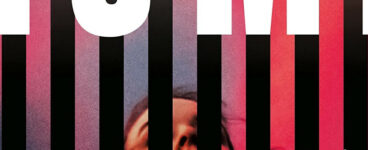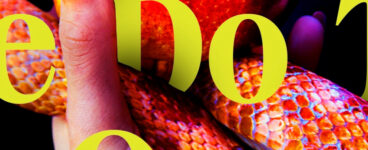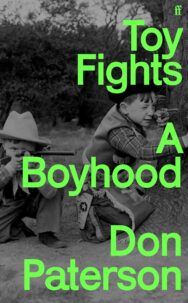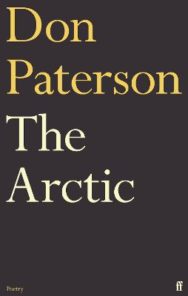David Robinson Reviews
‘I’d have one question to ask Paterson: will there be a second volume and, if so, how soon can I read it?’
David Robinson contemplates televisual adaptation as he finds Don Paterson’s childhood memoir compelling and impressive.
Toy Fights: A Boyhood
By Don Paterson
Published by Faber
Sometimes I think how easy it must be to be a TV commissioning editor. Of course, you’ll have to read a few duff books – all those narcissistic memoirs offering little more than an expanded CV, all achievements underlined, all old battles rehashed and revenged, all doubt and despair discreetly tidied away. But every now and again, there’ll be books like Don Paterson’s Toy Fights, which play out in your head as you read them.
Maybe you’d want to change the title. You could call it The Young Poet, for example, because after all that’s what most people know about Paterson: that he has won every poetry award going for his own stuff and has spent decades writing about, editing and teaching everyone else’s. Then again, maybe not. Because by the time Toy Fights ends, with the 20-year-old Paterson leaving Dundee on the London train to try his luck as a jazz guitarist, there’s not even a hint that this is how his life will eventually pan out.
By that stage, though, Paterson has already done something that eludes most memoirists. He has taken the reader into the mind he had – or at least a convincing version of it – as a teenager. This is an uncomfortable place to be – particularly so when, as a 16-year-old, he was hospitalised after an acute schizophrenic episode. I have never read a better description of what Baudelaire called ‘the wind of the wing of madness’ – a feeling of having no centre, of not knowing who answered when he was spoken to, of having a mind occupied by vandalising strangers, while all the time convinced that an irretrievable dissolution of the self is just a misstep away.
The teenage Paterson’s mental unravelling began with a panic attack that might have had something to do with some PCT-laced Afghan mixed with brown heroin he’d smoked in a squat near his Dundee home. Either way, this was when his sense of self started to crumble (‘I’d been bound hand and foot and thrown into the back seat of myself’). And so the journey through the outer circles of mental hell begins, and for these, a future poet – or at least someone with a talent for being precise about the imprecise – turns out to be an excellent guide. Other skills are needed too: an ability to capture the human comedy playing out in Ward 89 at Ninewells Hospital (check out the Billy Connolly-grade belter of an anecdote on pages 291-4) comes in handy, as does being able to write about such potentially numbing topics as medication changes without dropping the book’s drumbeat of sardonic pizazz. ‘These days,’ he writes, ‘thioridazine is only prescribed as a drug of last resort for schizophrenia since instant death was a popular side effect: it essentially puts Lars Ulrich in charge of your heartbeat, with all the manic enthusiasm, rank incompetence and stick-dropping potential that implies.’
In The Arctic, Paterson’s most recent poetry collection, he mentions writing with a ‘sentient curled lip’ and that precisely describes his prose too. It is relatively rare to find memoirs with such a consistent wry, self-assured, sardonic tone, especially when dealing with topics such as a childhood edged with poverty and a school which had only recently merged with a borstal, and where ‘on a regular day chairs were hurled through windows, legs ripped off pigeons and shites taken in teachers’ desk drawers’. Yet there’s a confidence in the writing that makes the Connolly comparison in my last paragraph not too much of a stretch. Here, for example, is Paterson describing the approach to his hometown:
‘What first-time rail traveller to Dundee has not crossed the bridge at sunset to gaze upriver at the broad, mountain-flanked Tay, shimmering like the rainbow-crossing of Bifröst itself – then turned to see the glittering, twinkling city rise up on its twin green hills, and not dreamed herself bound for some inexplicably unsung Shangri-La? And then pulled into Dundee station and gone: “Oh.”’
There’s plenty more where that came from (‘In Dundee “Closed for Refurbishment” was just a way of giving the fire brigade three days’ notice’), but just as impressive is the way Paterson can swivel to seriousness and back again. Like me, he had a spell as an obnoxious teenage Christian; unlike me, he went the whole Pentecostal hog, right down to speaking in tongues (‘It was, in the midst of the most psychologically damaging episode of my life, wildly cathartic’) with his own tongue liberated to make all the beautiful syllables he had ever imagined. Others, such as the group’s charismatic, bullying leader Luke, didn’t get much beyond repeating a couple of made-up words like Oombara coombara. ‘I was embarrassed for him, amazed no-one had ever pulled him aside to tell him to either shut up or make more of an effort.’
At such moments, it’s easy to imagine a TV commissioning editor rushing to buy up the rights to adapt the book and attempt to do on the screen what Paterson does on the page. Certainly, the laughs are there: Young Don turning up for the Boys Brigade and being made to unpick all 40 badges on the uniform his mother had bought from their neighbour; doing non-stop origami for a couple of years and even using the Evening Telegraph to appeal for fellow enthusiasts (headline: ‘Young Donald Is Seeking Fellow Paper-Folders’); not to mention the sheer sexual precocity of some members of the gang he loosely hung around with (‘I’ve shagged more lasses than you’ve had Mivvis, Donald,’ one ten-year-old tells him) and whose mock-serious fights give the book its title.
But Toy Fights goes deeper than anecdotage. It burns with rage at the neglect of the poor, bristles with musical knowledge and controversial opinions on identity politics, the internet, poetry, arts funding, and education, and even veers towards love. This is where the sentient curled lip uncurls and tries not to wobble, and it happens when his father strides into the picture in his cowboy boots, stetson, and huge bling buckle belt spelling out ‘Russ’. Russell L Paterson died of dementia three years ago, but is the other central figure in the book, heroically going without holidays and working his guitar-picking fingers to the bone to pay off hire purchase debts and provide the basics for his family. By day a colouring artist working on the Beano for DC Thomson, by night he made the local country music wannabes sound better than they really were. In the words of the poem dedicated to him in The Arctic:
… yet my father, on your one-two-three
took one breath to exhume your opening key
then shadowed you as with Apollo’s harp
through your ascent from E flat to K sharp.
This is why his father is so heroic – not because he is an obvious hero, but almost the opposite: he is helping someone reach the end of the song without drawing attention to himself, an act of compassion like – in the next verse’s lovely simile – ‘the Dalai Lama gently shepherding/ a drunken wasp towards an open window’. That’s what really counts, Paterson is saying, more than showing off or hogging the limelight. And while there’s a certain Dundonian rigour about not letting anyone get too big for their own boots – Paterson’s hatred of narcissists is visceral, intensified by the realisation that went deep into his mind aged 16, when he feared he was beginning to lose it, that ‘at the centre of us is not a self, but a clean hole.’
Narcissists – Luke the evangelical bully, for example, virtually any politician, or (I’ll add it for him) writer of the conventional look-at-me type of memoir – quite obviously can’t understand this. The full realisation of our inner fragility can, in this sense, be considered a gift, even if not the kind you would even wish on anyone. For a poet, though, doesn’t a remembered nearness to mental dissolution actually help when it comes to creating something out of nothing? Isn’t seeing things from a different angle part of what we expect from poetry?
I have no intention of wading into such deep waters, so I’ll merely pose the question and scamper back to dry land. But the fact that this is the kind of book that makes the reader think as well as imagine and (certainly) laugh out loud sets the bar high for anyone else – royal or commoner – with a memoir out this year. Toy Fights also expanded my musical horizons, not least in jazz guitar and consulting Google and YouTube so frequently about musos I’d never heard of but who rank highly in Paterson’s personal pantheon meant that it took me ages to read. And if I really were a TV commissioning editor, I’d have one question to ask Paterson: will there be a second volume and, if so, how soon can I read it?
Toy Fights: A Boyhood by Don Paterson is published by Faber, priced £16.99.
ALSO IN THIS ISSUE

 Home
Home
‘I look over at the Hand of God, panicked. But he’s just looking ahead and navigating the car throug …

 The Things We Do To Our Friends
The Things We Do To Our Friends
‘The inspiration around the book was friendship in all its glory, the negatives, and the positives.’














